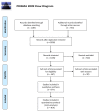Proposed Lyme Disease Guidelines and Psychiatric Illnesses
- PMID: 31505800
- PMCID: PMC6787753
- DOI: 10.3390/healthcare7030105
Proposed Lyme Disease Guidelines and Psychiatric Illnesses
Abstract
The Infectious Disease Society of America, American Academy of Neurology, and American Academy of Rheumatology jointly proposed Lyme disease guidelines. Four areas most relevant to psychiatry were reviewed-the disclaimer, laboratory testing, and adult and pediatric psychiatric sections. The disclaimer and the manner in which these guidelines are implemented are insufficient to remove the authors and sponsoring organizations from liability for harm caused by these guidelines. The guidelines and supporting citations place improper credibility upon surveillance case definition rather than clinical diagnosis criteria. The guidelines fail to address the clear causal association between Lyme disease and psychiatric illnesses, suicide, violence, developmental disabilities and substance abuse despite significant supporting evidence. If these guidelines are published without very major revisions, and if the sponsoring medical societies attempt to enforce these guidelines as a standard of care, it will directly contribute to increasing a national and global epidemic of psychiatric illnesses, suicide, violence, substance abuse and developmental disabilities and the associated economic and non-economic societal burdens. The guideline flaws could be improved with a more appropriate disclaimer, an evidence-based rather than an evidence-biased approach, more accurate diagnostic criteria, and recognition of the direct and serious causal association between Lyme disease and psychiatric illnesses.
Keywords: American Academy of Neurology (AAN); American Academy of Rheumatology (AAR); Infectious Disease Society of America (IDSA); Lyme disease; disclaimer; guidelines; mental illnesses; psychiatric; standards.
Conflict of interest statement
Robert Bransfield, MD has been an expert witness in cases involving neuropsychiatric manifestations, alcohol and drug abuse, opioid overdose death, violence and homicides involving Lyme borreliosis patients.
Figures
References
-
- IDSA/AAN/ACR Draft Lyme Disease Guidelines. [(accessed on 4 August 2019)]; Available online: https://www.idsociety.org/practice-guideline/Lyme-Disease-Guideline-Publ...
-
- Koons C. Latest Suicide Data Show the Depth of U.S. Mental Health Crisis. [(accessed on 4 August 2019)];2019 Jun 20; Bloomberg Businessweek. Available online: https://www.bloomberg.com/news/articles/2019-06-20/latest-suicide-data-s....
-
- Wormser G.P., Dattwyler R.J., Shapiro E.D., Halperin J.J., Steere A.C., Klempner M.S., Krause P.J., Bakken J.S., Strle F., Stanek G., et al. The clinical assessment, treatment, and prevention of Lyme disease, human granulocytic anaplasmosis, and babesiosis: Clinical practice guidelines by the Infectious Diseases Society of America. Clin. Infect. Dis. 2006;43:1089–1134. doi: 10.1086/508667. - DOI - PubMed
Publication types
LinkOut - more resources
Full Text Sources


